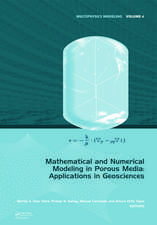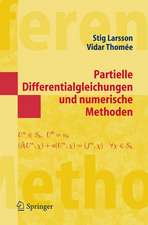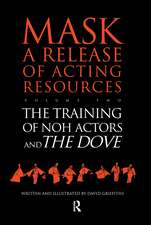Numerical Methods for Ordinary Differential Equations: Initial Value Problems: Springer Undergraduate Mathematics Series
Autor David F. Griffiths, Desmond J. Highamen Limba Engleză Paperback – 25 noi 2010
It covers the topics traditionally treated in a first course, but also highlights new and emerging themes. Chapters are broken down into `lecture' sized pieces, motivated and illustrated by numerous theoretical and computational examples.
Over 200 exercises are provided and these are starred according to their degree of difficulty. Solutions to all exercises are available to authorized instructors.
The book covers key foundation topics:
o Taylor series methods
o Runge--Kutta methods
o Linear multistep methods
o Convergence
o Stability
and a range of modern themes:
o Adaptive stepsize selection
o Long term dynamics
o Modified equations
o Geometric integration
o Stochastic differential equations
The prerequisite of a basic university-level calculus class is assumed, although appropriate background results are also summarized in appendices. A dedicated website for the book containing extra information can be found via www.springer.com
Din seria Springer Undergraduate Mathematics Series
-
 Preț: 319.90 lei
Preț: 319.90 lei -
 Preț: 237.41 lei
Preț: 237.41 lei -
 Preț: 319.02 lei
Preț: 319.02 lei -
 Preț: 325.20 lei
Preț: 325.20 lei -
 Preț: 238.28 lei
Preț: 238.28 lei -
 Preț: 237.29 lei
Preț: 237.29 lei -
 Preț: 265.92 lei
Preț: 265.92 lei -
 Preț: 236.87 lei
Preț: 236.87 lei -
 Preț: 236.97 lei
Preț: 236.97 lei -
 Preț: 240.63 lei
Preț: 240.63 lei -
 Preț: 237.18 lei
Preț: 237.18 lei -
 Preț: 283.11 lei
Preț: 283.11 lei -
 Preț: 359.15 lei
Preț: 359.15 lei -
 Preț: 358.55 lei
Preț: 358.55 lei -
 Preț: 221.92 lei
Preț: 221.92 lei -
 Preț: 224.54 lei
Preț: 224.54 lei -
 Preț: 358.82 lei
Preț: 358.82 lei -
 Preț: 301.10 lei
Preț: 301.10 lei -
 Preț: 383.17 lei
Preț: 383.17 lei -
 Preț: 229.86 lei
Preț: 229.86 lei -
 Preț: 268.37 lei
Preț: 268.37 lei -
 Preț: 166.75 lei
Preț: 166.75 lei -
 Preț: 239.86 lei
Preț: 239.86 lei -
 Preț: 266.70 lei
Preț: 266.70 lei -
 Preț: 269.99 lei
Preț: 269.99 lei - 15%
 Preț: 526.67 lei
Preț: 526.67 lei -
 Preț: 320.20 lei
Preț: 320.20 lei -
 Preț: 272.49 lei
Preț: 272.49 lei -
 Preț: 272.69 lei
Preț: 272.69 lei -
 Preț: 258.88 lei
Preț: 258.88 lei -
 Preț: 265.83 lei
Preț: 265.83 lei -
 Preț: 265.18 lei
Preț: 265.18 lei -
 Preț: 275.36 lei
Preț: 275.36 lei -
 Preț: 278.24 lei
Preț: 278.24 lei -
 Preț: 266.70 lei
Preț: 266.70 lei -
 Preț: 275.74 lei
Preț: 275.74 lei -
 Preț: 328.08 lei
Preț: 328.08 lei -
 Preț: 265.78 lei
Preț: 265.78 lei -
 Preț: 275.74 lei
Preț: 275.74 lei -
 Preț: 273.45 lei
Preț: 273.45 lei -
 Preț: 277.32 lei
Preț: 277.32 lei -
 Preț: 270.57 lei
Preț: 270.57 lei -
 Preț: 273.63 lei
Preț: 273.63 lei -
 Preț: 270.19 lei
Preț: 270.19 lei -
 Preț: 265.36 lei
Preț: 265.36 lei -
 Preț: 265.36 lei
Preț: 265.36 lei -
 Preț: 268.08 lei
Preț: 268.08 lei -
 Preț: 272.86 lei
Preț: 272.86 lei -
 Preț: 272.69 lei
Preț: 272.69 lei -
 Preț: 271.16 lei
Preț: 271.16 lei
Preț: 269.60 lei
Nou
Puncte Express: 404
Preț estimativ în valută:
51.60€ • 56.07$ • 43.38£
51.60€ • 56.07$ • 43.38£
Carte tipărită la comandă
Livrare economică 21 aprilie-05 mai
Preluare comenzi: 021 569.72.76
Specificații
ISBN-13: 9780857291479
ISBN-10: 0857291475
Pagini: 271
Ilustrații: XIV, 271 p. 69 illus.
Dimensiuni: 155 x 235 x 15 mm
Greutate: 0.41 kg
Ediția:2010
Editura: SPRINGER LONDON
Colecția Springer
Seria Springer Undergraduate Mathematics Series
Locul publicării:London, United Kingdom
ISBN-10: 0857291475
Pagini: 271
Ilustrații: XIV, 271 p. 69 illus.
Dimensiuni: 155 x 235 x 15 mm
Greutate: 0.41 kg
Ediția:2010
Editura: SPRINGER LONDON
Colecția Springer
Seria Springer Undergraduate Mathematics Series
Locul publicării:London, United Kingdom
Public țintă
Upper undergraduateCuprins
ODEs—An Introduction.- Euler’s Method.- The Taylor Series Method.- Linear Multistep Methods—I: Construction and Consistency.- Linear Multistep Methods—II: Convergence and Zero-Stability.- Linear Multistep Methods—III: Absolute Stability.- Linear Multistep Methods—IV: Systems of ODEs.- Linear Multistep Methods—V: Solving Implicit Methods.- Runge–Kutta Method—I: Order Conditions.- Runge-Kutta Methods–II Absolute Stability.- Adaptive Step Size Selection.- Long-Term Dynamics.- Modified Equations.- Geometric Integration Part I—Invariants.- Geometric Integration Part II—Hamiltonian Dynamics.- Stochastic Differential Equations.
Recenzii
From the reviews:
“This book by Griffiths (Univ. of Dundee, UK) and Higham (Univ. of Strathclyde, UK) introduces the fields of numerical analysis and scientific computation. … Overall, there are many examples and exercises for students to read and try. … The work is very readable for an introductory course. An undergraduate who has completed at least the full calculus sequence should find the material interesting and accessible. Summing Up: Recommended. Lower-division undergraduates.” (S. L. Sullivan, Choice, Vol. 48 (10), June, 2011)
“There is a place for an elementary text that concentrates on the mathematical aspects while still referring to the applications of initial-value ODEs, and have set out to produce such a book. … Each chapter ends with a set of graded exercises … . In addition, there are worked examples throughout the book that illustrate the important ideas being covered. … a preparatory text for students taking a graduate course in numerical analysis. … this book is very well suited to its intended purpose.” (Philip W. Sharp, Mathematical Reviews, Issue 2012 g)
“This book provides material for a first typical course introducing numerical methods for initial-value ordinary differential equations but also highlights some new and emerging themes. … The authors include a wealth of theoretical and numerical examples that motivate and illustrate the fundamental ideas … . Although the book is aimed to be used by undergraduate students I felt that it might well be of interest to academic teachers in the field. … I highly recommend the book … .” (Rolf Dieter Grigorieff, Zentralblatt MATH, Vol. 1209, 2011)
“This textbook introduces undergraduates in mathematics, engineering and the physical sciences to the use of numerical methods for solving ordinary differential equations. … The primary practical goal of the book is to show students what’s going on inside scientific computing software, and to give them a sense of the strengths and limitations of numerical methods. … This is an attractive, very readable introduction to the subject for students … .” (William J. Satzer, The Mathematical Association of America, May, 2011)
“This book by Griffiths (Univ. of Dundee, UK) and Higham (Univ. of Strathclyde, UK) introduces the fields of numerical analysis and scientific computation. … Overall, there are many examples and exercises for students to read and try. … The work is very readable for an introductory course. An undergraduate who has completed at least the full calculus sequence should find the material interesting and accessible. Summing Up: Recommended. Lower-division undergraduates.” (S. L. Sullivan, Choice, Vol. 48 (10), June, 2011)
“There is a place for an elementary text that concentrates on the mathematical aspects while still referring to the applications of initial-value ODEs, and have set out to produce such a book. … Each chapter ends with a set of graded exercises … . In addition, there are worked examples throughout the book that illustrate the important ideas being covered. … a preparatory text for students taking a graduate course in numerical analysis. … this book is very well suited to its intended purpose.” (Philip W. Sharp, Mathematical Reviews, Issue 2012 g)
“This book provides material for a first typical course introducing numerical methods for initial-value ordinary differential equations but also highlights some new and emerging themes. … The authors include a wealth of theoretical and numerical examples that motivate and illustrate the fundamental ideas … . Although the book is aimed to be used by undergraduate students I felt that it might well be of interest to academic teachers in the field. … I highly recommend the book … .” (Rolf Dieter Grigorieff, Zentralblatt MATH, Vol. 1209, 2011)
“This textbook introduces undergraduates in mathematics, engineering and the physical sciences to the use of numerical methods for solving ordinary differential equations. … The primary practical goal of the book is to show students what’s going on inside scientific computing software, and to give them a sense of the strengths and limitations of numerical methods. … This is an attractive, very readable introduction to the subject for students … .” (William J. Satzer, The Mathematical Association of America, May, 2011)
Textul de pe ultima copertă
Numerical Methods for Ordinary Differential Equations is a self-contained introduction to a fundamental field of numerical analysis and scientific computation. Written for undergraduate students with a mathematical background, this book focuses on the analysis of numerical methods without losing sight of the practical nature of the subject.
It covers the topics traditionally treated in a first course, but also highlights new and emerging themes. Chapters are broken down into `lecture' sized pieces, motivated and illustrated by numerous theoretical and computational examples.
Over 200 exercises are provided and these are starred according to their degree of difficulty. Solutions to all exercises are available to authorized instructors.
The book covers key foundation topics:
o Taylor series methods
o Runge-Kutta methods
o Linear multistep methods
o Convergence
o Stability
and a range of modern themes:
o Adaptive stepsize selection
o Long term dynamics
o Modified equations
o Geometric integration
o Stochastic differential equations
The prerequisite of a basic university-level calculus class is assumed, although appropriate background results are also summarized in appendices. A dedicated website for the book containing extra information can be found via www.springer.com
It covers the topics traditionally treated in a first course, but also highlights new and emerging themes. Chapters are broken down into `lecture' sized pieces, motivated and illustrated by numerous theoretical and computational examples.
Over 200 exercises are provided and these are starred according to their degree of difficulty. Solutions to all exercises are available to authorized instructors.
The book covers key foundation topics:
o Taylor series methods
o Runge-Kutta methods
o Linear multistep methods
o Convergence
o Stability
and a range of modern themes:
o Adaptive stepsize selection
o Long term dynamics
o Modified equations
o Geometric integration
o Stochastic differential equations
The prerequisite of a basic university-level calculus class is assumed, although appropriate background results are also summarized in appendices. A dedicated website for the book containing extra information can be found via www.springer.com
Caracteristici
Focuses on the analysis of numerical methods without losing sight of the practical nature of the subject Covers topics traditionally treated in a first course, but also highlights new and emerging themes Chapters are broken down into `lecture' sized pieces, motivated and illustrated by numerous theoretical and computational examples Includes supplementary material: sn.pub/extras Request lecturer material: sn.pub/lecturer-material













